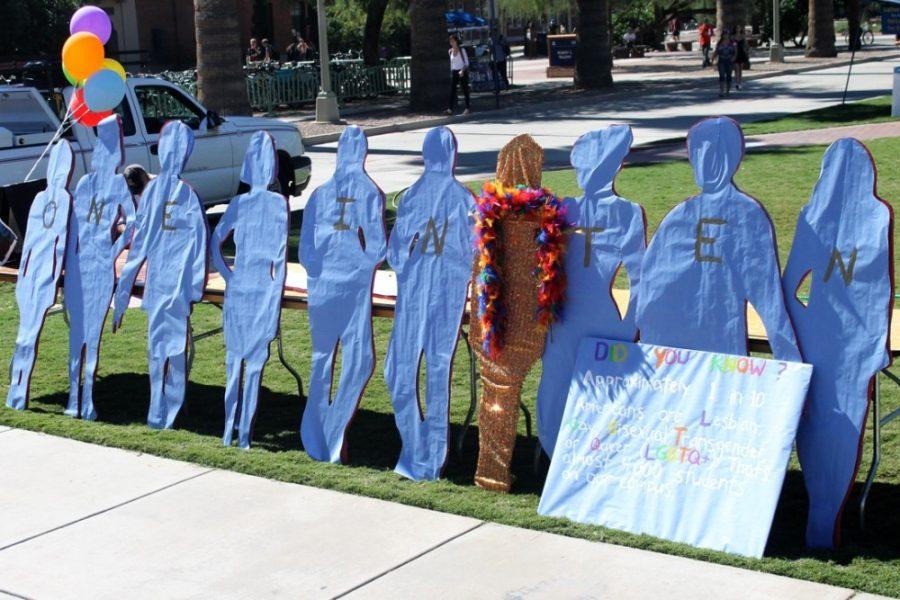A study conducted and lead-authored by Russell Toomey, a University of Arizona associate professor of family and consumer sciences, found significant results in identifying which groups of transgender adolescents are more at risk of suicide than others transgender individuals.
Toomey and his colleagues found that transmasculine adolescents, those who were assigned female at birth but identify as male, and non-binary teens, those who may not identify specifically as male or female, are at the greatest risk for attempting suicide.
Published Sept. 11 in Pediatrics, a peer-reviewed medical journal, the study is also of use for information about transgender adults. It can also provide information to transgender youth to potentially prevent suicide in the LGBTQ+ community.
RELATED: Trans Day of Remembrance held at Old Main
“As an undergraduate student, I was taking a class … and I read one of the first articles ever on suicide attempts among lesbian and gay youth,” Toomey said. “I was really struck by the big difference between [suicide percentage] in heterosexual and lesbian and gay youth. I’ve been really passionate about my research since that point about understanding the experiences in transgender youth, specifically.”
Toomey also mentioned the deficiency in research for transgender individuals, as they only make up around two to three percent of the population. In his study, he analyzed data from a national survey provided to over 120,000 students within a 36-month period between 2012 and 2015.
Most teens in the data were cisgender, or people who identify with the gender they were assigned at birth, but the statistics for suicide rates in transgender teens grants insight to a much bigger issue at hand.
The researchers found that 50.8 percent of transmasculine adolescents between the ages of 11 and 19 have made a suicide attempt at least once before, and 41.8 percent of nonbinary adolescents have attempted suicide. The third most at-risk adolescent groups were transfeminine, those who were assigned male at birth but identify as female, at 29.9 percent and those questioning their gender identity, at 27.9 percent.
“I am not surprised by a lot of [the research] because I work within the community so I get to experience a lot of the people who are involved in those statistics, and I get to hear a lot of their experiences in terms of why they feel so depressed or anxious,” said Dante Salas, a senior public management and policy major and Pride Alliance co-director for UA’s LGBTQ Affairs. “It’s mostly not because of their gender identity but because of how they’re treated.”
The statistic for cisgender teens was much lower as for females, 17.6 percent said they had attempted suicide, while the number was 9.8 percent for males. Overall, nearly 14 percent of adolescents reported to have attempted suicide at least once before in their lifetime.
Toomey and his coauthors also looked into other factors of adolescents that may have influenced these numbers such as race, ethnicity, parents’ educational attainment and the neighborhoods where they grew up.
“Once you dismantle that toxic view of what gender is supposed to look like or what it’s supposed to be, then acceptance comes along easier,” Salas said. Salas added that education and acceptance are the two biggest parts in beginning the pathway to lowering these statistics.
Eric D. Smith, assistant professor of practice in the Department of Educational Psychology within the College of Education, also agreed with Salas’s statement.
“It would be helpful for the community at large to educate themselves on these gender issues. They are taking more and more prominence on our daily lives,” Smith said. “We are on a college campus, we are collectively a community of scholars, so folks need to educate themselves … With society moving the way it is, that will become even more important.”
Because the research was so focused on what specific transgender adolescents are most at-risk of suicide, Toomey’s research opens doors to new topics within the field of gender studies.
“I think it’s awesome that we have a researcher here at the U of A that is carrying out this work, because it is highly impactful,” said Smith.
RELATED: UA LGBTQ community reacts to Trump rescinding trans bathroom guidelines
Toomey mentioned continuing his research to understand more about what the public can do to resolve gender issues. Beyond acceptance, there are many other factors that can help in improving this issue such as family support, school support and resources for counseling and mental-health support.
“Our next study that we are working on now is trying to understand protective factors in youth environments, specifically for transgender youth, that can help reduce these numbers seen in the study,” he said. “Learning the language, taking Safe Zone training, for instance, and looking through LGBTQ Student Affairs on campus would be helpful for the campus community to learn that … language is one of the most fundamental pieces of moving towards more acceptance.”
If you or someone you know is struggling with suicidal thought or may be contemplating suicide, please call either the National Suicide Prevention Lifeline at 1-800-273-8255 or Trans Lifeline at 877-565-8860. Trans Lifeline is for members of the transgender community and is staffed by all transgender operators.
Follow Lauren Albrecht on Twitter









